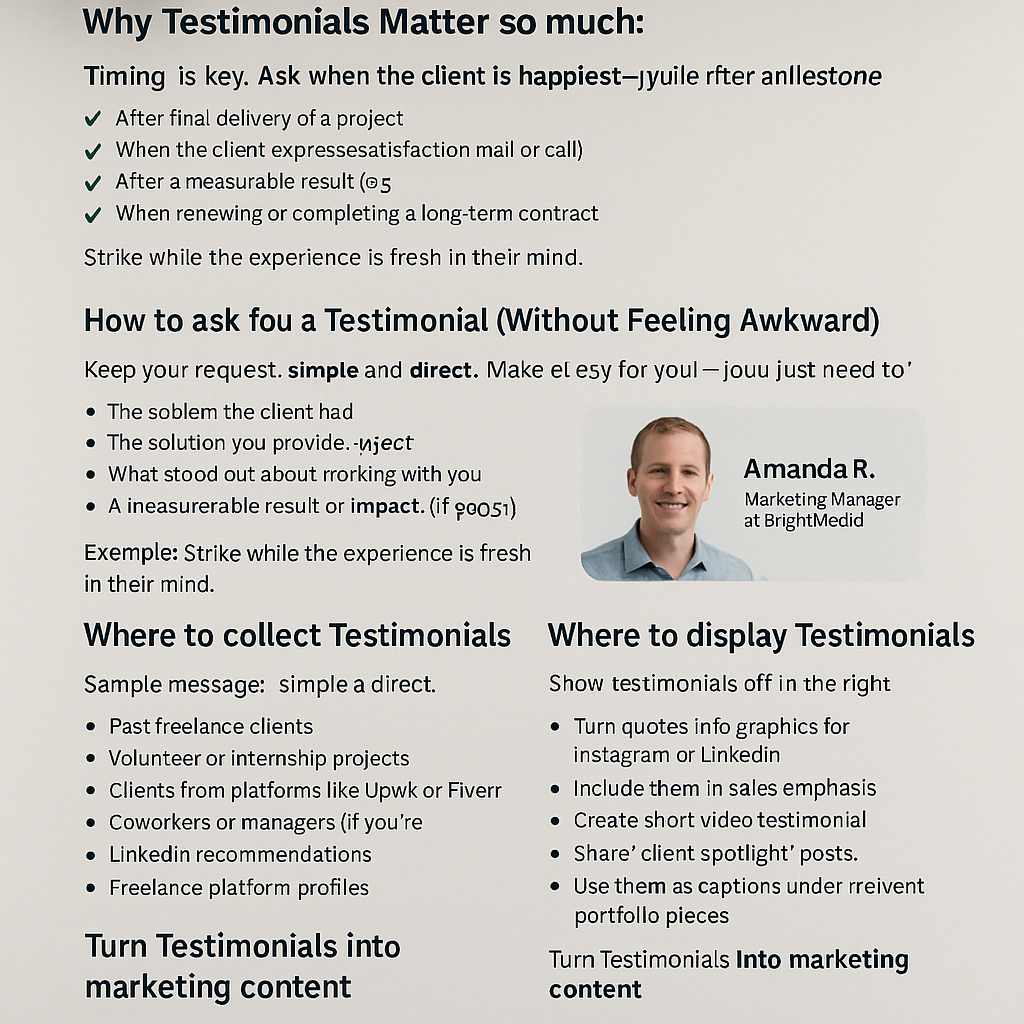In the freelance world, trust is everything. Before a client hires you, they want proof that you can deliver. And one of the most powerful forms of proof is a testimonial. A great testimonial builds credibility, eases doubts, and helps you close deals faster. In this article, you’ll learn how to collect, craft, and use testimonials strategically to grow your freelance business.
Why Testimonials Matter So Much
Testimonials aren’t just nice compliments—they’re a trust-building tool that tells potential clients:
✅ You’ve worked with real people
✅ You’ve delivered real results
✅ You’re reliable and professional
✅ Others had a great experience with you
People trust other people more than they trust marketing. Testimonials provide social proof that builds confidence.
When Should You Ask for a Testimonial?
Timing is key. Ask when the client is happiest—usually right after a successful delivery or milestone.
Ideal moments:
- After final delivery of a project
- When the client expresses satisfaction via email or call
- After a measurable result (e.g., sales increase, more leads)
- When renewing or completing a long-term contract
Strike while the experience is fresh in their mind.
How to Ask for a Testimonial (Without Feeling Awkward)
Keep your request simple and direct. Most clients are happy to help—you just need to make it easy for them.
Sample message:
Hi [Client Name],
I really enjoyed working on [project name] with you! If you’re happy with the results, I’d truly appreciate a short testimonial to share on my website or portfolio. Just a few lines about your experience working with me would be perfect.No pressure at all—and thank you again!
You can also offer to draft a version they can edit, especially if they’re busy.
What Makes a Great Testimonial?
Not all testimonials are equal. The best ones are specific and highlight the before-and-after experience.
Strong testimonials include:
- The problem the client had
- The solution you provided
- What stood out about working with you
- A measurable result or impact (if possible)
Example:
“Before working with Alex, our blog was inconsistent and barely ranked. Within three months, he helped us triple our organic traffic. He’s not just a great writer—he understands strategy.”
Where to Collect Testimonials
Start with:
- Past freelance clients
- Volunteer or internship projects
- Clients from platforms like Upwork or Fiverr
- Coworkers or managers (if you’re transitioning from a job)
Even one or two testimonials can build trust—especially when starting out.
Where to Display Testimonials
Once you have them, show them off in the right places.
Best places:
- Your website (especially homepage, about, and services pages)
- Portfolio or project case studies
- Proposal PDFs or pitch decks
- Social media posts (with visuals)
- LinkedIn recommendations
- Freelance platform profiles
Visual testimonials (with a face or logo) have more impact than plain text.
How to Format Testimonials for Impact
Make them easy to read and trust:
✅ Use full names and job titles
✅ Include a headshot or company logo
✅ Bold key phrases for emphasis
✅ Break up long paragraphs
Better than this:
“Great job. Highly recommend.”
Try this:
“Working with Jordan was smooth from start to finish. He handled our video editing with creativity and speed—and the final product was exactly what we needed.”
— Amanda R., Marketing Manager at BrightMedia
Turn Testimonials Into Marketing Content
Don’t let testimonials just sit on your website—repurpose them into powerful content.
Ideas:
- Turn quotes into graphics for Instagram or LinkedIn
- Include them in sales emails
- Create short video testimonials
- Share “client spotlight” posts
- Use them as captions under relevant portfolio pieces
Testimonials become marketing tools when used creatively.
Bonus: Video Testimonials
Video builds trust even faster. If a client is willing, ask them to record a 30–60 second clip sharing their experience.
Tips:
- Offer 2–3 guiding questions
- Keep it informal (Zoom or phone camera is fine)
- Edit lightly and add captions if needed
Video testimonials are perfect for websites, YouTube, and landing pages.
What If You’re Just Starting Out?
Don’t worry if you don’t have client testimonials yet.
Alternatives:
- Ask for character references from colleagues or teachers
- Offer discounted or free work in exchange for a review
- Create mock projects and include hypothetical feedback
- Highlight feedback from short-term gigs or even one-time tasks
Start where you are—and build from there.
Final Thoughts: Build Trust With Every Project
In freelancing, your reputation is your brand. Testimonials help build that reputation, one project at a time.
So deliver great work, ask at the right moment, and use those testimonials everywhere you can. They’re not just compliments—they’re conversion tools that sell your services when you’re not in the room

